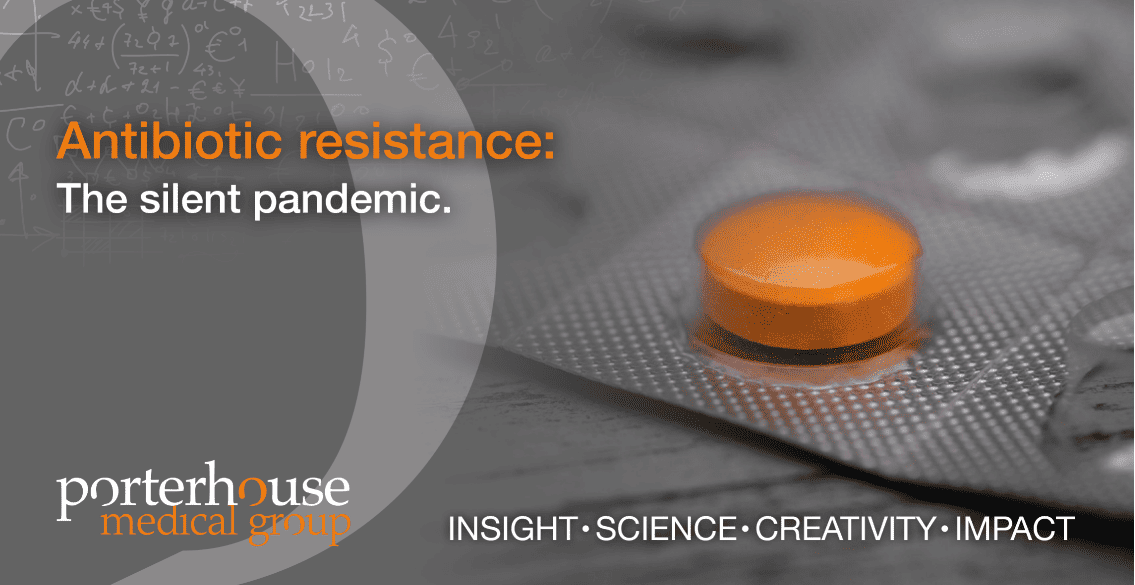Antibiotic resistance: The silent pandemic
November 18, 2019 | #WAAW, Medical Communications, Porterhouse Medical Group, World Antibiotic Awareness Week, antibiotic resistance
Porterhouse is proud to support World Antibiotic Awareness Week. Our article aims to improve awareness of one of the biggest threats to global health today: antibiotic resistance.

Today, 18 November, marks the start of World Antibiotic Awareness Week, an annual event since 2015 that aims to improve awareness of one of the biggest threats to global health today: antibiotic resistance [1]. Since the discovery of antibiotics in 1929 by Alexander Fleming, they have arguably become one of the most influential medical advancements in history, but overuse in both humans and animals now threatens to undo almost a century of progress [2, 3].
Antibiotic resistance
Antibiotics are medicines used in the treatment and prevention of bacterial infections. Like all organisms, bacteria evolve and adapt to their environment naturally by evolution, but the use of antibiotics accelerates this process [3]. Survival of the fittest dictates that the strains able to survive antibiotic use are the ones that have the opportunity to reproduce, resulting in a resistant bacteria population. The problem has arisen not only from overuse of antibiotics in humans but also treatment and prevention measures in animals, leading to resistant ‘superbugs’ spreading to humans through the food chain and water supply [2–4].
The impact
An increasing number of common infections such as pneumonia, tuberculosis, gonorrhoea and salmonellosis are becoming harder to treat as antibiotics become less effective. In a globalised world, infectious diseases can travel long distances in relatively short periods of time, making the problem of resistance one that is relevant to all seven billion of us [1].
The short-term results are longer hospital stays, the requirement of second- and third-line antibiotics resulting in higher medical costs, and increased mortality [1, 2]. In the longer term, we may be heading towards a post-antibiotic era where common infections and minor injuries can once again be fatal. In addition, it puts many of the achievements of modern medicine such as organ transplants, chemotherapy and surgeries such as caesarean sections in jeopardy as without effective treatment for infection these procedures have far more risk associated with them [1].
The global statistics
- 123 countries report extensive multi-drug resistant tuberculosis
- 700,000 people are estimated to die each year from drug-resistant infections
- Up to 2 billion people, mainly in low- and middle-income countries, lack access to antimicrobials
- A three-fold rise in global antibiotic consumption is predicted by 2030
- There have been no new classes of antibiotics discovered since the 1980s [5]
Positive strategies
The good news is that, as individuals we all have the ability to reduce antibiotic resistance and preserve these vital treatments for future generations.
Rather than relying on antibiotics to treat infections, we need to be more vigilant in primary prevention by:
- Regularly washing hands
- Keeping vaccinations up to date
- Preparing food hygienically
- Practising safe sex
- Avoiding close contact with unwell people [2].
Antibiotics should only be prescribed when absolutely necessary; patients should follow the advice of healthcare professionals and never demand them. Courses should be finished, and any medication leftover should not be shared [2, 3].
Globally, we need to ensure that these medicines are used more prudently in both people and animals through better diagnostics, access to the right drugs and improved regulation [6].A better system for monitoring drugs supplies is also needed (where they are shipped, how they are distributed), as well as monitoring and reporting of the prevalence of drug-resistant infections in humans and animals [7].
In 2019, it is still estimated that more than 50% of antibiotics in many countries are used inappropriately. In June of this year, the WHO launched the AWaRe tool globally, which classifies antibiotics into three groups: Access, Watch and Reserve. Its aim is to increase the global use of antibiotics in the Access category (narrow-spectrum, more specific antibiotic) to 60% and reduce the use of antibiotics in the Watch and Reserve groups as these are most at risk from resistance [8].
The future
Antibiotic resistanceis a silent pandemic and a major threat to global health, but we are by no means powerless in tackling the problem. It will take a huge effort by research scientists, policy makers, clinicians and individuals, but by working together we can make a difference.
References
- World Health Organization. Antibiotic resistance. Available at: https://www.who.int/news-room/fact-sheets/detail/antibiotic-resistance. Accessed November 2019.
- St. George’s University. What is antibiotic resistance? A look at this international health problem. Available at: https://www.sgu.edu/blog/medical/what-is-antibiotic-resistance/. Accessed November 2019.
- UK Research and Innovation. An introduction to antimicrobial resistance. Available at: https://www.ukri.org/research/themes-and-programmes/tackling-antimicrobial-resistance/an-introduction-to-antimicrobial-resistance/. Accessed November 2019.
- yourgenome. What is antibiotic resistance? Available at: https://www.yourgenome.org/facts/what-is-antibiotic-resistance. Accessed November 2019.
- HM Government. Tackling antimicrobial resistance 2019–2024: The UK’s five-year national action plan. Available at: https://assets.publishing.service.gov.uk/government/uploads/system/uploads/attachment_data/file/784894/UK_AMR_5_year_national_action_plan.pdf. Accessed November 2019.
- Health Europa. Rapid diagnostic technologies versus antimicrobial resistance. Available at: https://www.healtheuropa.eu/antimicrobial-resistance/88272/. Accessed November 2019.
- World Health Organization. WHO global strategy for containment of antimicrobial resistance. Available at: who.int/drugresistance/WHO_Global_Strategy_English.pdf. Accessed November 2019.
- World Health Organization. WHO releases the 2019 AWaRe Classification Antibiotics. Available at: https://www.who.int/medicines/news/2019/WHO_releases2019AWaRe_classification_antibiotics/en/. Accessed November 2019.
This content was provided by Porterhouse Medical Group




